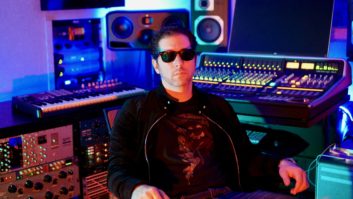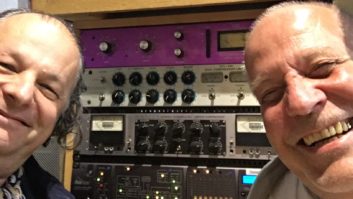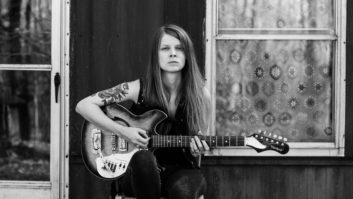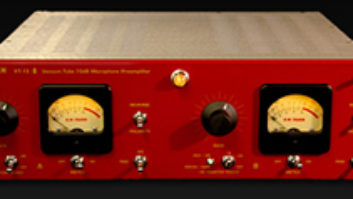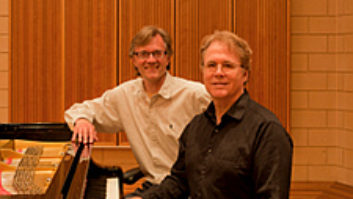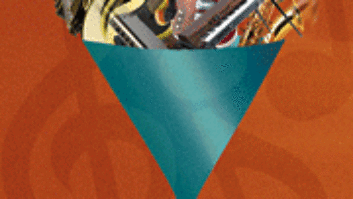VACUUM TUBE LC EQUALIZER
With an uncompromising approach to audio processing, D.W.Fearn’s VT-4 Vacuum Tube LC EQ follows in the steps of thecompany’s single-channel VT-1 and 2-channel VT-2 Vacuum Tubemicrophone preamplifiers. In fact, much of the amplifier circuitdesign in this unit is based on those two mic pre’s. I feelprivileged to write about the VT-4, because it’s immediatelyapparent that this handmade “labor of love” is in itsown special class, and company owner Douglas Fearn individuallyinspects, tests and signs each unit.
The VT-4 is a single-channel equalizer in a three-rackspacecabinet. Everything about the construction is first-class and builtto last. The chassis is fabricated of heavy-gauge, anodizedaluminum plate, and the ¼-inch-thick front panel is finishedin D.W. Fearn red to match the VT-1/VT-2 units. The large, mil-speccontrol knobs are from original Raytheon designs that are nowmanufactured by Electronic Hardware Inc. The heavy-duty AC poweron/off switch is located on the back panel, away from sensitiveaudio lines and accidental “use” during a recording.The internal power supply fully regulates both the high voltagesand DC-filament voltage. No pots are used: All controls aresemisealed, silver contact-type, with rotary switches forrepeatability. All audio capacitors are polystyrene orpolypropylene, and resistors are 1% metal film. The inductors andinput/output transformers are custom-made by JensenTransformers.
SIGNAL PATH
The VT-4’s passive EQ circuit is surrounded by Class-A modeinput and output amplifiers using Svetlana 6N1P dual triodes. Bothamps are similar with single-ended triode sections coupled tocathode follower circuits. After the input transformer, the inputamplifier isolates the passive equalizer circuit, whose output isthen fed to the output amplifier and output transformer. The unitis designed to accept balanced or unbalanced signals and outputline-level, balanced +4dBm signals. LC refers to using inductors orcoils (L) and capacitors (C) in the series/parallel filtercircuitry, rather than the typical RC equalizers that use resistors(R) and capacitors to keep costs and physical size down. Passiveequalizers using LC networks sound noticeably more“open” and smooth.
GETTING IN AND OUT
A large In/Out switch toggles the EQ in and out of circuit bysubstituting a resistive attenuator equaled to the level drop ofthe passive EQ circuit when all controls are set to flat. This isnot a hard-wired bypass and works better, because you’ll hear justthe sound of the tube input/output amplifiers sans EQ. It would becrazy to leave an EQ this good patched in Bypass mode. I did noticean occasional soft pop when I operated this switch, and sincereceiving my unit (serial #008), a new“make-before-break” switch was added to the newerunits, eliminating all possibility of noise.
The Input Level control adjusts gain of the first amp stage in3dB steps from -9 dB to +9 dB. For the most part, I kept thisswitch at unity or the center position. Fearn says: “thiscontrol is for maintaining proper headroom within the unit.”This control worked fine for adding level when I was able, bygrounding pin 3 of the input XLR connector, to process -10dBvunbalanced signals. If you boost several frequencies at once, thenyou may have to dial back the input level to keep from overloadingthe output amplifier. Of course, if you wanted the sound of anoverloaded tube stage, then you can crank the Input Level up andget lots of wonderful (albeit expensive) distortion. For thispurpose, it would be nice to have an Output Level control, becausethe unit will put out up to +22 dBm.
EQ CONTROLS
There are five frequency controls or bands on the VT-4. Gaincontrol knobs are intuitively located directly below each frequencycontrol. Exact frequency selection is different on the VT-4 thanall other EQs and contributes to its unique sound. I found myselflooking at frequency choice a little differently and makingslightly different judgments and decisions throughout the session.These were decisions and judgments I was very happy with the nextday! Douglas Fearn said he arrived at his frequency choices bymostly listening in a musical and subjective way. I’ll bet somegood old trial and error and a few clip leads went into it aswell!
Low frequencies are handled by shelving Low Boost and Low Cutcontrols. The selectable frequency positions for Low Boost are 20,40, 60 and 140 Hz, while the Low Cut control can be set to 30, 40,100 or 400 Hz. These sets of overlapping frequencies make forinteresting equalizer “stylings,” which were differentfrom conventional EQs or even multiband parametrics. Perhaps it’sidiosyncratic — like an old Pultec EQP-1 — but you canboost and cut in the same frequency ranges! Typically, boosting lowfrequencies by large amounts will cause muddiness or boominess.However, using the VT-4 to boost 60 Hz — while cutting theoctave down at 30 Hz — gave me more bottom with much lessboominess.
The next control is the unique bell-shaped Mid Cut. Midrangefrequencies available for attenuation are 200, 300, 400, 500, 600and 700 Hz. You can cut up to 16 dB in 2dB steps. This is aprogressive Q equalizer: As the Mid Cut control is advanced, the Qbecomes sharper. This huge range is quite a sound change, and Iwondered if Doug played electric guitar, because I liked thisfeature for “scooping” out midrange from guitar tracks.My only wish here was for a 1.5kHz position in the frequency rangeselection. As such, the VT-4 does not have a dedicated midrangeboost control, although the next section, High Boost, does go downto 2 kHz.
High Boost is a bell-shaped equalizer with 2, 3, 4, 5, 8, 10, 12and 16kHz frequency selection positions. You can boost up to 14 dBin 2dB steps. I would like to see a 1kHz position here: Then theequalizer would have complete overlapping frequency rangeselection. High Boost includes a Q or bandwidth control that goesfrom a broad 0.6 to 1.7 at the sharpest. I found this section justperfect for brightening vocals, guitars or drums. I never heard anystridency or harshness, no matter how much I cranked the HighBoost.
High Cut, the last control, is a shelving EQ, and itsfrequencies are 1.7, 4, 10 or 28 kHz. Twenty-eight kHz? The 28kHzsetting is just the ticket for rolling off digital artifacts youpick up sometimes. I brightened a guitar track (recorded in ProTools) with the High Boost section and then rolled off at 28 kHz tolose some aliasing artifacts I started to hear. As with Low Boostand Cut, using both High Boost and High Cut at the same frequenciesproduces a whole other equalizer sound with interestingeffects.
ALL THERE!
A great-sounding equalizer with more tone-shaping possibilitiesthan most other tube EQs, the VT-4 is crafted and built to last,like a Rolls Royce made for the U.S. Government. The D.W. FearnVT-4, at $3,900 MSRP, makes a fine investment for any recording andmixing studio. Thanks go to producer David Gamson for use of hisstudio and helping me with my evaluation of the VT-4.
D.W. Fearn, 182 Bragg Hill Road, West Chester, PA 19382;610/793-2526; fax 610/793-1479; www.dwfearn.com.
Barry Rudolph is an L.A.-based recording engineer. Visit hisWebsite at www.barryrudolph.com.
